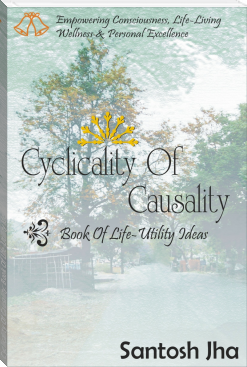Be Lonely, Be Your Best - Santosh Jha (the gingerbread man read aloud .TXT) 📗

- Author: Santosh Jha
Book online «Be Lonely, Be Your Best - Santosh Jha (the gingerbread man read aloud .TXT) 📗». Author Santosh Jha
It has to be understood and accepted with all humility and compassion that a real good human is not one who needs to think and then behave and act good. Rather, it is one who does not have to think, as all his behaviours and actions are instinctively bound to be good. We don’t consciously remember when we drive a car or cook a meal as it is instinctive, even when they were once learned behaviours. Objective goodness is also learned behaviour. But when we repeatedly practice it, it becomes instinctive.
Neuroplasticity is also about this objective intellect. It is about consciously aligning with desirable intangibles of life and then practice them with mindfulness of higher consciousness, helped by meditation. This then becomes structured in our brains. This means, goodness and wellness is no more our choice, but it has become an auto-mode virtue, an optionless absoluteness for us.
That is why we have been insisting that loneliness is a positive state of being as it creates a space for mindfulness and option-building towards the ultimate optionlessess of goodness and wellness.
**
Creating A Personalized Spiritual Model
For Lasting Connect With Happy Milieus
Thank you so much for patiently being with me all along. Now we are into the conclusive part of the book and surely, we are going to talk about the very crucial idea of Happiness of Loneliness. This comes after we have already talked in detail about the high utility of the true notions about loneliness. We shall now talk about how we can use this beautifully awarding facility of loneliness for our true happiness.
However, before we do that, I humbly request you to wait a bit and allow me to say you something very crucial, as a summing up exercise, in the next few paragraphs, so that we could then finally come down to the concluding part of Happiness of Loneliness.
Old and very trusted ancient wisdom has a prescription, which has transcendental utility. We all shall be better off, if we accept that. This surely helps us hitting the homeostatic poise in our lives, especially in contemporary clutter culture.
Ancient Indian wisdom said, first and ultimate wisdom is acceptance of the mortality – not only of life, self, but all things around and beyond us. This emotion of acceptance of mortality renders a self, a consciousness, which naturally aligns with all things, intangible, soft and immortal. This consciousness then evolves itself towards spiritualism, which is a staple for consciousness. We need to understand mortality wisdom in its holism. Kindly spare some precious time and loads of positivity for getting to the core of the idea as how acceptance of mortality stands as core and cardinal element of true spiritualism.
Our ancestors, around 3000 years back, had little distractions of modern and contemporary life, even though they had evolved to a stage of civilization, where life-living had become manageably comfortable. As population pressure on natural resources was very little and needs of life were few, they had loads of quality leisure time – which we must accept as Spiritual Loneliness. The poise they had within and as they accepted the utility of this precious Spiritual Loneliness, this led them to be keen observers of every little thing around.
They could decipher a design, a pattern in almost everything that happened or presented themselves to them. Humans have the most developed facility of mind consciousness for observance and imagination. These two innate facilities made our ancestors decipher so many patterns in the nature around them, in their lives and even in the universe, they could visualize. They started to put these patterns – both tangible and intangible, into actionable ideas. It is also very natural and we all even today do the same. Those were days, when our ancestors only had the human tools of observations and imaginations as means of corroboration.
However, they had the genius to engender such ideas, which were self-evident and self-corroborative in their immediate milieus. They beautifully picked up symbols and metaphors from nature to elaborate and substantiate their ideas. They are part of philosophic and spiritual traditions but actually, they also happen to be the crude resource for scientific enquiry and substantiation. The core philosophy is based not on ideas, which modern contemporary world can label as pure imagination of idle and primitive minds. They can be and should ideally be accepted as observations of realisms, present in the cosmic mechanism and in the microcosm of human lives and their social living by people, who had the most receptive mind consciousness. That is why the core philosophy seems so self-evident and self-corroborative. The core idea emanates out of a realism, which is finality even today and shall always remain the ultimate finality. This finality is mortality.
We need to put aside or unlearn our contemporary populist consciousness, which is so used to popular modern ideas and benchmarks. It is a popular way of thinking that death is the end. Our worthy ancestors accepted it as the beginning of life. We too are just accepting the basic premise here as one final truth and that is why the inevitable has to be accepted as the beginning of all ideas of life.
When the hypothesis is right, the idea has better chances of being right. The core Indian philosophy starts with finality as the initiation of all ideas of life. That is why it is self-evident and self-corroborative. Our worthy ancestors could decipher that even in the definitive and inevitable pattern of mortality; there was overall continuity and immortality, which permeated in the milieus around them. They could decipher that in nature, there were elements, which remained continuous and immortal in totality, even while part of it decayed in cyclic mechanism.
This masterly observation was made available to the genius of imagination and it could be unravelled to them that every life on earth too has core elements, which are continuous and immortal, even when part of it decays in time. This core observation engendered the idea of two distinct but simultaneous elements of the cosmic realism –
The mortal and discontinuous,
The immortal and continuous.
They also discovered that within human life too, the same twin elements existed. The body was mortal and aligned to discontinuous cosmic elements but the elemental consciousness deep within was immortal and aligned with continuous elements. The subjective feeling of me, the self as distinct and different from other human being was just a virtual bridge between the twin realisms of mortality and immortality. This subjective consciousness Einstein called optical delusion.
This core idea became the cornerstone of a philosophy, which is enshrined in the cardinal Indian spiritual system. The yoga philosophy also adheres to this core idea. Yoga in ancient Indian language of Sanskrit means union of the immortal elements within a human being with the cosmic elements of immortality. Yoga is a process of attaining the union of jeevatma (the microcosmic consciousness of living beings) with parmatma (the ultimate macrocosmic consciousness of cosmos). This core idea also led to a belief-system, which decided the ultimate utility and purpose of all lives. Yogic philosophy presents a self-evident and self-corroborative idea of why and what is the true way of living one’s life.
The core idea was tested empirically in the social milieu. The best laboratory to test and validate any idea empirically is the human body-mind mechanism itself. The patterns of human action and behaviour corroborated the idea and they finally became a social practice and part of the larger culture of that time.
The culture this core idea evolved, accepted that in life, everyone is naturally inclined to maximize joys and minimize pains. It was accepted that self-welfare is the cardinal goal of life for every living being and this is attainable through self-interface or self-dialogue (aatma-sakchhatkar). The wise of our civilization empirically observed that living beings are in constant and causative relationship with elements of nature. This nature also exists in microcosmic form within living beings. In nature, there are both mortal and immortal elements. They observed that mortal elements are usually expressed in tangible matter and immortal ones in intangible form. They deciphered that human being could attain their lasting and continuous wellness only when they establish a relationship with immortal and intangible elements of nature and life.
The philosophy they engendered says –
True and lasting relationship can happen only between similar and generic elements.
This is the idea, yogic philosophy practices in totality and perfection. Yogic philosophy maintains that even the matter shall finally lead to a-matter, tangible shall lead to intangible and mortal elements shall lead to immortal elements. This is because, empirically, true and lasting relationship can happen only between similar and generic elements. The five senses of body mechanism shall initially orient a person to consumption and gratification. However, the same five senses automatically and finally leads to the realization that these consumptions and gratifications are ephemeral and mortal. This is self-evident and self-corroborative as every human knows that mortality is inevitable and the ultimate realism.
Yogic philosophy admits it as self-evident for all that all pleasures of body and all joys of gratifications have the inbuilt and inherent energy advocating against it. The energies of attachments and gratifications are entwined with the inverse energies of detachment and renunciation. That is why, within a human being, the desire and will to have a life of absolute detachment and renunciation is as powerful as the desire and will for a life of attachment and gratification. This dualism is instinctive but unravelled only by a higher consciousness.
This idea is crucial in understanding and accepting as why people in contemporary culture of instant self gratification, overdrive of consumption and multitasking for more material attainments are growingly feeling the ultimate emotions of loneliness. They fail to accept the dualism, which our consciousness engenders for us. More we align ourselves with tangible and mortal elements of life and living, more reverse emotions we shall experience towards intangible and immortal elements. Loneliness needs to be accepted as a function of this dualism of our mind consciousness. Once we accept the above notion of mortality and the dualism it creates for us, we shall come out of the dualism and loneliness shall become an empowering thing for us.
The philosophy, which enshrines the ideals of purpose of life as attainment of perpetuity of wellness, therefore extends this empirically self-evident and self-corroborative fact. It says that every human being should consciously opt for a relationship with only the intangibly expressed continuous and immortal elements of nature, both within the nature of the body-mind consciousness as well as the nature outside in physically and tangibly expressed domain. It says that anyone can decipher the practical realism that the flow of energy of gratification is also joyous but it ends up in the finality of pain and emptiness. Whereas, the energy flow of detached consciousness keeps augmenting like a flame in the fireplace, which is self-energized by constant offering of renounced elements of consciousness.
We can here see very clearly that spiritualism must not be confused with religion, divinity or god. Spiritualism has a very simple, very secular and purely earthy definition. Modern scientists and consciousness researchers say that there is an intuitive perception in all of us that we are part of a universe that is a unified whole. This idea is central to the thought of we all. We all have this innate need to see and find ourselves in unity and harmony of the milieus around us, from our ambient social milieus to the extreme of the cosmos. Everything tangible and





Comments (0)